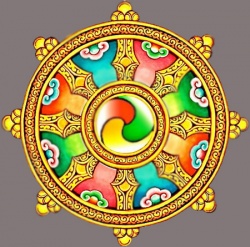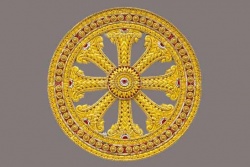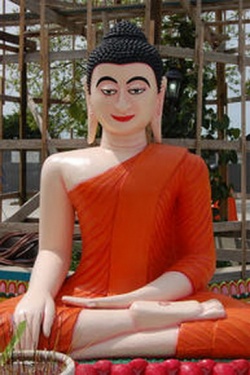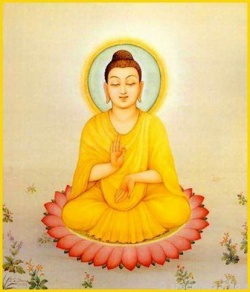Uttaratantra Shastra
Uttaratantra Shastra (Skt. Mahāyānottaratantra Śāstra; Tib. ཐེག་པ་ཆེན་པོ་རྒྱུད་བླ་མའི་བསྟན་བཆོས་, Gyü Lama; Wyl. theg pa chen po rgyud bla ma'i bstan bcos), Treatise on the Sublime Continuum or the Ratnagotravibhaga.
One of the Five Treatises of Maitreya, a commentary on the teachings of the third turning of the wheel of Dharma explaining buddha nature.
It was first translated into Tibetan by Ngok Loden Sherab and the Kashmiri pandita Sajjana.
It is included among the so-called "Thirteen great texts", which form the core of the curriculum in most shedras and on which Khenpo Shenga provided commentaries.
Famous Quotations
དམ་པའི་དོན་དུ་འགྲོ་བ་ཡི། །
སྐྱབས་ནི་སངས་རྒྱས་ཉག་གཅིག་ཡིན། །
ཐུབ་པ་ཆོས་ཀྱི་སྐུ་ཅན་ཕྱིར། །
ཚོགས་ཀྱང་དེ་ཡི་མཐར་ཐུག་ཕྱིར། །
On an ultimate level
The only refuge is the Buddha.
The Muni embodies the Dharma,
And is thus the culmination of the sangha.
Maitreya, Sublime Continuum, I, 21
The text has seven vajra points. These points come within the five chapters:
The Tathagatagarbha
Awakening/Enlightenment (bodhi)
Enlightened Qualities
The Activity of the Tathagatas
Benefits of the Text
མ་དག་མ་དག་དག་པ་དང༌། །
ཤིན་ཏུ་རྣམ་དག་གོ་རིམ་བཞིན། །
སེམས་ཅན་བྱང་ཆུབ་སེམས་དཔའ་དང༌། །
དེ་བཞིན་གཤེགས་པ་ཞེས་བརྗོད་དོ། །
According to the phases of impure,
Partially pure and completely pure,
We speak of sentient beings, bodhisattvas
And the thus-gone buddhas.
Maitreya, Sublime Continuum, I, 47
མི་གཙང་བ་ལ་དྲི་ཞིམ་མེད་བཞིན་འགྲོ་ལྔ་དག་ན་བདེ་བ་མེད། །[1]
Just as there can be no pleasant fragrance in a cesspit,
There is no joy among the five classes of beings.
Maitreya, Sublime Continuum, IV, 50
སེར་སྣ་ལ་སོགས་རྣམ་རྟོག་གང༌། །
དེ་ནི་ཉོན་མོངས་སྒྲིབ་པར་འདོད། །
འཁོར་གསུམ་རྣམ་པར་རྟོག་པ་གང༌། །
དེ་ནི་ཤེས་བྱའི་སྒྲིབ་པར་འདོད། །
Any thought such as miserliness and so on
Is held to be an afflictive obscuration.
Any thought of ‘subject’, ‘object’ and ‘action’
Is held to be a cognitive obscuration.
Maitreya, Sublime Continuum, V, 14
རྫོགས་སངས་སྐུ་ནི་འཕྲོ་ཕྱིར་དང༌། །
དེ་བཞིན་ཉིད་དབྱེར་མེད་ཕྱིར་དང༌། །
རིགས་ཡོད་ཕྱིར་ན་ལུས་ཅན་ཀུན། །
རྟག་ཏུ་སངས་རྒྱས་སྙིང་པོ་ཅན། །
Because the perfect Buddhas’s kaya is all-pervading,
Because reality is undifferentiated,
And because they possess the potential,
Beings always have the buddha nature.
Maitreya, Sublime Continuum, I, 27
རྣམ་དབྱེ་བཅས་པའི་མཚན་ཉིད་ཅན། །
གློ་བུར་དག་གིས་ཁམས་སྟོང་གི །
རྣམ་དབྱེ་མེད་པའི་མཚན་ཉིད་ཅན། །
བླ་མེད་ཆོས་ཀྱིས་སྟོང་མ་ཡིན། །
The disposition is empty of the adventitious stains,
Which are characterized by their total separateness.
But it is not empty of the unsurpassed qualities,
Which have the character of total inseparability.
Maitreya, Sublime Continuum, I, 155
ནད་ནི་ཤེས་བྱ་ནད་ཀྱི་རྒྱུ་ནི་སྤང་བྱ་ལ། །
བདེ་གནས་ཐོབ་བྱ་སྨན་ནི་བསྟེན་པར་བྱ་བ་ལྟར། །
སྡུག་བསྔལ་རྒྱུ་དང་དེ་འགོག་པ་དང་དེ་བཞིན་ལམ། །
ཤེས་བྱ་སྤང་བྱ་རིག་པར་བྱ་ཞིང་བསྟེན་པར་བྱ། །
Illness must be understood, its causes eliminated,
Wellbeing must be attained, and medicine taken.
Likewise, suffering, its causes, their cessation and the path
Must in turn be understood, eliminated, realized and relied upon.
Maitreya, Sublime Continuum, IV, 55
Commentaries
In Sanskrit
Bali 8 hindu.jpg
Asanga, Ratnagotravibhāgavyākhyā
In Tibetan
Rongtön Sheja Kunrig, ཐེག་པ་ཆེན་པོ་རྒྱུད་བླ་མའི་བསྟན་བཅོས་ལེགས་པར་བཤད་པ་, [[theg pa chen po rgyud bla ma'i bstan bcos legs}} par bshad pa]] (currently being translated by John Whitney Pettit for the Library of Tibetan Classics series)
Jamgön Kongtrul Lodrö Tayé, [[ཐེག་པ་ཆེན་པོ་རྒྱུད་བླ་མའི་བསྟན་བཅོས་སྙིང་པོའི་དོན་མངོན་སུམ་ལམ་གྱི་བཤད་སྲོལ་དང་སྦྱར་བའི་རྣམ་པར་འགྲེལ་པ་ཕྱིར་མི་ལྡོག་པ་སེང་གེའི་ང་རོ]]་, theg pa chen po rgyud bla ma'i bstan bcos snying po'i don mngon sum lam gyi bshad srol dang sbyar ba'i rnam par 'grel pa phyir mi ldog pa seng ge'i nga ro (translated by Fuchs, see below)
Mipham Rinpoche, རྒྱུད་བླ་མའི་མཆན་འགྲེལ་མི་ཕམ་ཞལ་ལུང་, rgyud bla ma'i mchan 'grel mi pham zhal lung (currently being translated by John Canti of the Padmakara Translation Group for the Tsadra Foundation)
Translations
In English
Buddha-Nature, Mahayana Uttaratantra Shastra by Arya Maitreya with commentary by Dzongsar Jamyang Khyentse Rinpoche, edited by Alex Trisoglio, Khyentse Foundation, 2007. A free copy can be requested online at siddharthasintent.org.
Buddha Nature (with Jamgön Kongtrul's commentary) translated by Rosemarie Fuchs, Snow Lion, New York 2000
The Changeless Nature, translated by Ken and Katia Holmes, Karma Kagyu Trust, Newcastle 1985
Uttaratantra-shastra (rgyud bla ma), Maitreya – Asanga with commentary by Jamgön Mipham, Padmakara translation group, forthcoming






